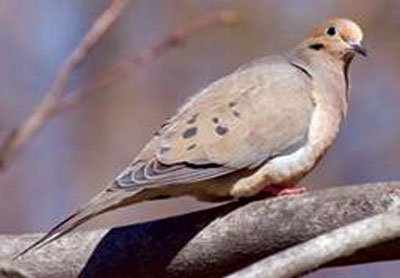There must be a more prudent way of purging pigeon poop! Several
birds were recently brought to the Wildlife Education and
Rehabilitation Center (WERC) because they had been dreadfully
injured while struggling to remove themselves from sticky glue
traps. Even if they do escape the traps, they will soon die because
the damage to delicate feathers prevents them from flying well and
evading predators.
There must be a more prudent way of purging pigeon poop! Several birds were recently brought to the Wildlife Education and Rehabilitation Center (WERC) because they had been dreadfully injured while struggling to remove themselves from sticky glue traps. Even if they do escape the traps, they will soon die because the damage to delicate feathers prevents them from flying well and evading predators.
These traps are put out by people who want to get rid of pigeons roosting on their housetops (and of mice scampering underfoot). Alas, the traps also catch doves, finches, swallows, sparrows and other small songbirds that happen to alight for a short rest.
The rescued birds must be quickly treated with special solutions and then carefully washed to make sure all the residue has been removed. WERC staff has received special training for cleaning oil-spilled aquatic birds and wildlife, which prepared them for handling birds stuck with other gluey substances, including, in one unusual case, molasses.
As gentle as WERC’s volunteers are, the little birds are still extremely stressed from this process, which sometimes must be repeated several times before their feathers are clean. There is then a long period of recovery until their feathers molt or regain water-proofing. Heartbreakingly, some of these birds die in spite of intensive care, due to severe wing and tail injuries or because they had swallowed some of the toxic glue.
The Mourning Dove certainly had a reason to be mournful. It was brought in with wing and tail feathers forcefully pulled out by the glue.
Its breast feathers were badly stuck together and there was glue on its feet. Happily, it recuperated beautifully after several months under WERC’s TLC and when released, flew gracefully into a nearby tree.
There is a better way to shoo those pigeons. According to the Humane Society of the United States, preferred methods include models of owls, hawks, snakes and cats, although these vary in effectiveness, depending on how realistic they are and how often they are moved.
Mylar tape streamers hung around the roosting area may also be effective. Liquid and fogging repellants using methyl anthranilate (a type of grape juice extract) are approved for discouraging pigeons and starlings.
Special netting properly draped on a building will also keep pigeons from roosting on the rooftop and ledges. Details on this and other humane methods of banishing pigeons can be found on the H.S.U.S. Web site www.hsus.org/wildlife/urban–wildlife–our–wild–neighbors/solving–problems–with–your–wild–neighbors/












